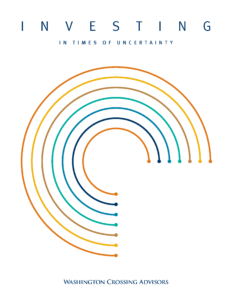Insight & Commentaries
A small glimmer of hope is concealed in recent data trends. Here are a few examples: The number of Covid-19 U.S. cases fell for the fourth week in a row (chart A, below), and deaths decreased for the first time last week (chart B, below). Unemployment insurance claims also fell for the fourth consecutive week (chart C, below). Domestic air traffic posted small gains last week (chart D, below) as did transit hubs (chart E, below). Credit spreads changed little for the third week in a row (chart F, below), and analysts trimmed less than $1 from S&P 500 earnings…
Read More ›
Before we can hope to see a turn for the better, we must first see signs of stabilizing. For the most part, this is what we see in the most recent data. We try to discern the path to recovery in the week-to-week data: virus trends, by looking at cases and deaths across the United States; economic trends, by looking at mobility and reports of real economic activity; and market trends, by looking at the response of key financial indicators. This week’s analysis showed us that the economic hole is deep, but the rate of falloff is slowing. Slowing Spread…
Read More ›
Stocks rallied last week on talk of reopening the economy and the S&P 500 is about half way back to February highs. The lockdown is helping to slow cases of coronavirus, but the economy is taking a beating as a result. Judging by recent data, the U.S. economy is likely contracting at an annualized pace in the range of -15% to -22% (chart, below). Over 10 million Americans filed for unemployment insurance in the past month. Estimates of potential job losses range from 23 million (Goldman Sachs) to 47 million (St. Louis Federal Reserve). The speed of the present downturn…
Read More ›
A strong case can be made for dividend growth investing. The Case for Rising Dividends explores the rationale and evidence behind the dividend growth philosophy.
Read More ›
The 2020 coronavirus outbreak is taking a toll and investing in times of uncertainty can be challenging. Large moves in stock and bond prices have again become the rule rather than the exception. We would like to share a series of exhibits and perspective pieces that you might find helpful in navigating today’s turbulent markets.
Read More ›
Tactical asset allocation in CONQUEST portfolios is discussed in this quarterly series. In this quarterly installment, we discuss how CONQUEST is adapting to rapid changes brought about by the outbreak of Covid-19. An encouraging start to the year gave way to the unsettling reality of a global pandemic last month. In very short order, financial markets responded to extraordinary societal changes. Since February 19, global stock markets shed a record $25 trillion (30%) in a matter of days after Covid-19 became a pandemic. Bond markets and commodities also exhibited volatility and complicated movements. Not since 1987 have markets adjusted with…
Read More ›
It is not too soon to start imagining a post-virus world. At some point, this will pass into the history books. For now, personal survivability is paramount until whenever that day comes. Surviving means doing everything possible to stay physically healthy. The investing analog holds as well — the key for investors now is corporate survivability. We believe now is the time to play it safe, focus on quality, and avoid buying low-quality, cheap stocks. Bad News Ahead The next phase will be full of bad news about the economy. Last week’s 3.25 million weekly unemployment insurance claims report is…
Read More ›
In just a month’s time, the U.S. stock market’s value is back to where it was in late 2018. The speed and intensity of the recent decline is unusual as the United States’ equity markets lost $11 trillion (30%) in just one month. This 30% decline is also reflected in the Dow Jones Industrial Average seen below. The chart shows how this episode compares with past notable declines. In contrast to a month’s time, it took eight months for the Dow to give up 30% during the 2000-2002 market decline and fourteen months for the index to shed that amount…
Read More ›
An eruption of volatility hit markets last week as the World Health Organization declared Covid-19 a pandemic. This extraordinary outbreak will throw out of kilter many aspects of daily lives. Markets are rapidly reestimating risk and trying to predict the size and duration of the shock to the global economy. Central banks and governments are also stepping up response to unfolding conditions. Yesterday, the Federal Reserve cut their benchmark interest rate by 100 basis points (-1.0%) to a range of 0-0.25%, committed to buying $500 billion of U.S. Treasuries and $200 billion of mortgage-backed securities, and took other measures to…
Read More ›
Bond prices continue to surge, driven by coronavirus fears and a new oil price war. Prices of long-term U.S. Treasury bonds are rising rapidly, sending bond yields to record lows. Bonds at the longest end of the U.S. Treasury curve are approaching gains of 20-30% year-to-date. Similar bond price action occurred in the past, but never before have U.S. interest rates reached levels seen today. U.S. 20-year Treasury yields have now fallen through one percent, following the 10-year Treasury amid a broader global pattern of rapidly declining and ultra-low rates. The 30-year U.S. Treasury bond yield currently stands at a…
Read More ›




The Case for Rising Dividends
A strong case can be made for dividend growth investing. The Case for Rising Dividends explores the rationale and evidence behind the dividend growth philosophy.
Read More ›